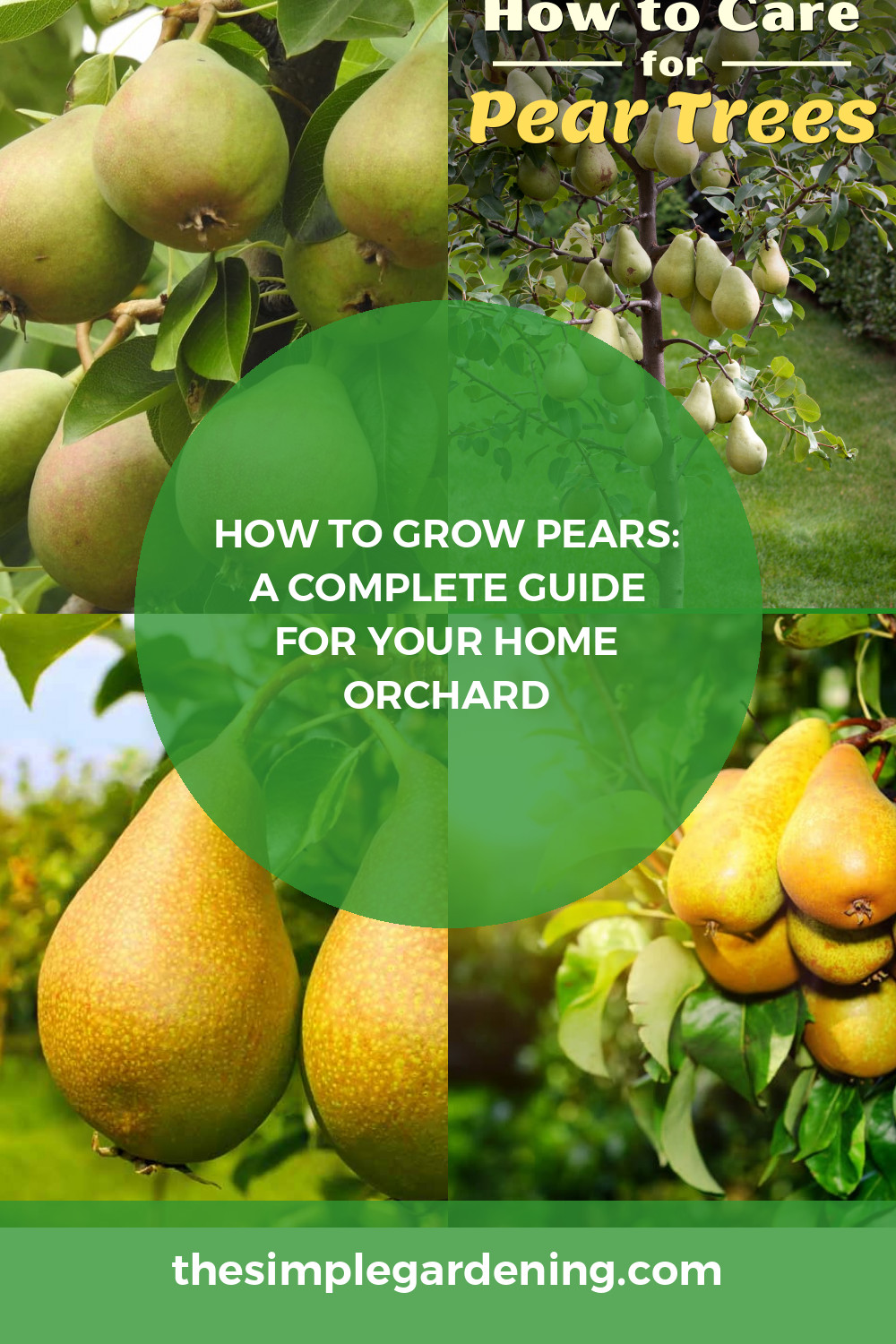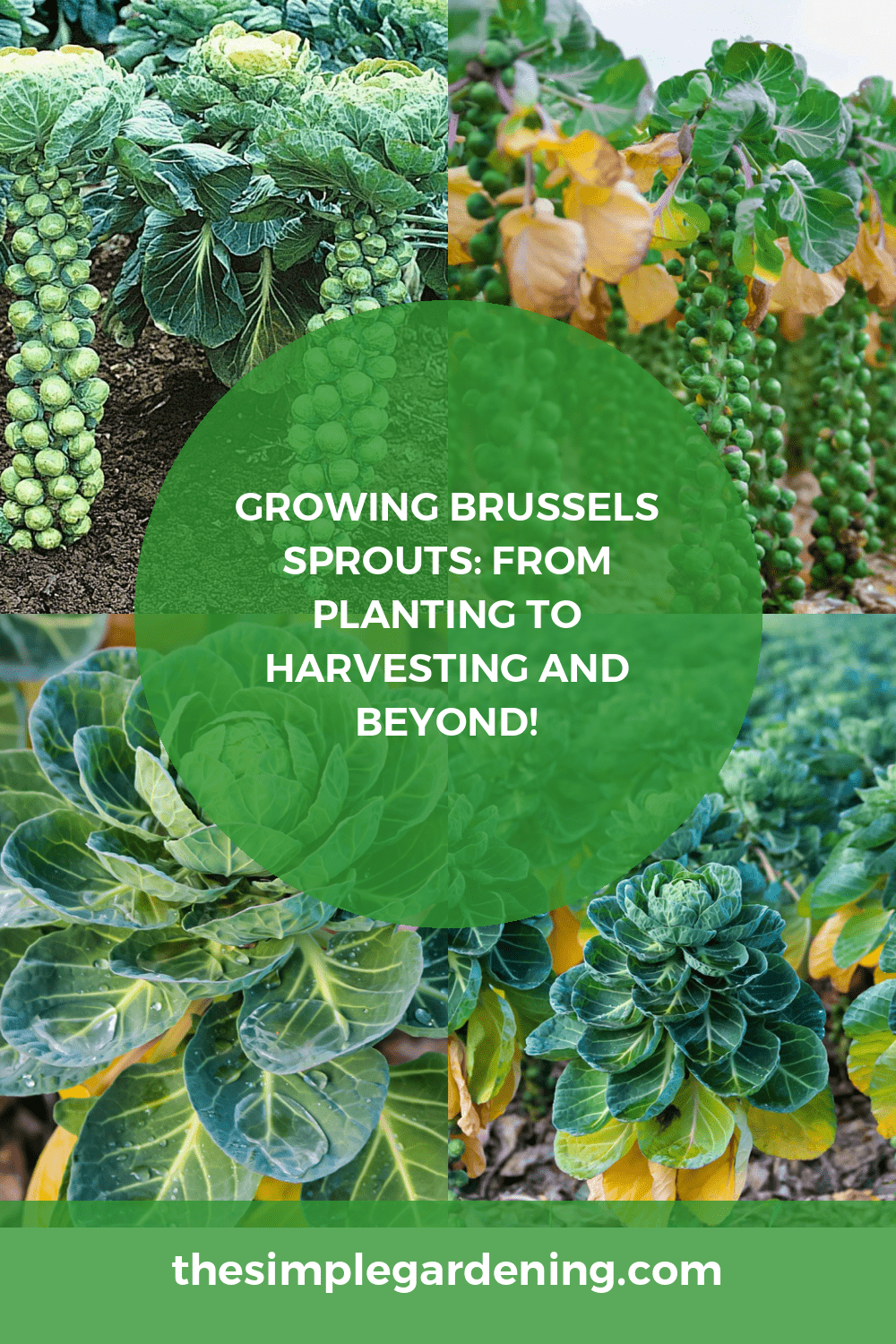Growing pears in your garden can be a delightful and rewarding experience. With their sweet, juicy fruits and beautiful spring blossoms, pear trees add both aesthetic value and delicious produce to your home landscape. This guide will walk you through everything you need to know about growing pears, from selecting the right variety to advanced growing techniques.
Introduction to Growing Pears
Pears have been cultivated for thousands of years and are prized for their versatility and health benefits. Whether you’re a beginner or an experienced gardener, growing pears can be a gratifying endeavor.
History and Origins of Pear Cultivation
Pears have a rich history dating back to ancient civilizations. Originally cultivated in regions of Europe and Asia, they have since spread globally.
| Region | History |
|---|---|
| Europe | Cultivated since ancient times; popular in Roman era |
| Asia | Long history in China; key varieties originated here |
| North America | Introduced by early settlers; adapted well to climate |
| Middle East | Integral to diets; historical trade fruit |
| Ancient Civilizations | Symbol of immortality and luxury |
Benefits of Growing Pears
Growing your own pears offers numerous benefits:
- Nutritional Value: High in fiber, vitamin C, and antioxidants.
- Cost Savings: Reduces grocery bills.
- Freshness: Home-grown pears are fresher and tastier.
- Environmental Impact: Reduces carbon footprint by minimizing transportation.
Overview of Different Pear Varieties
Pears come in various shapes, sizes, and flavors. Understanding the different varieties helps in selecting the best one for your needs.
| Variety | Description | Use |
|---|---|---|
| Bartlett | Sweet, juicy; most common variety | Fresh eating, canning |
| Bosc | Firm, dense; great for baking | Baking, poaching |
| Anjou | Mild, sweet; good for salads | Fresh eating, salads |
| Asian Pears | Crisp, apple-like texture | Fresh eating |
| Comice | Very sweet, creamy texture | Fresh eating, desserts |
Selecting the Right Pear Variety
Choosing the right pear variety is crucial for a successful harvest. Consider your climate, the tree’s disease resistance, and the intended use of the fruit.
Climate and Zone Considerations
Pears thrive in temperate climates. Understanding your USDA hardiness zone helps in selecting the best variety.
| Zone | Temperature Range | Suitable Varieties |
|---|---|---|
| 4-6 | -30°F to -10°F | Bartlett, Anjou, Bosc |
| 7-9 | 0°F to 30°F | Asian Pears, Comice, Seckel |
| 10-11 | Above 30°F | Limited; requires special care |
Disease Resistance
Opt for varieties with resistance to common pear diseases like fire blight and scab.
| Disease | Resistant Varieties |
|---|---|
| Fire Blight | Kieffer, Moonglow, Seckel |
| Scab | Anjou, Bosc, Asian Pears |
| Pear Rust | Resistant rootstocks available |
Flavor Profiles and Uses
Selecting based on flavor and use ensures you get the most out of your harvest.
| Use | Recommended Varieties |
|---|---|
| Fresh Eating | Bartlett, Comice, Asian Pears |
| Canning | Bartlett, Anjou, Seckel |
| Baking | Bosc, Anjou |
| Juicing | Bartlett, Anjou, Kieffer |
Popular Pear Varieties for Home Gardens
For home gardeners, certain varieties are particularly well-suited.
| Variety | Characteristics |
|---|---|
| Bartlett | Versatile, early-producing |
| Kieffer | Hardy, disease-resistant |
| Moonglow | Smooth skin, fire blight resistant |
| Seckel | Small, very sweet |
| Asian Pears | Crisp, unique texture |
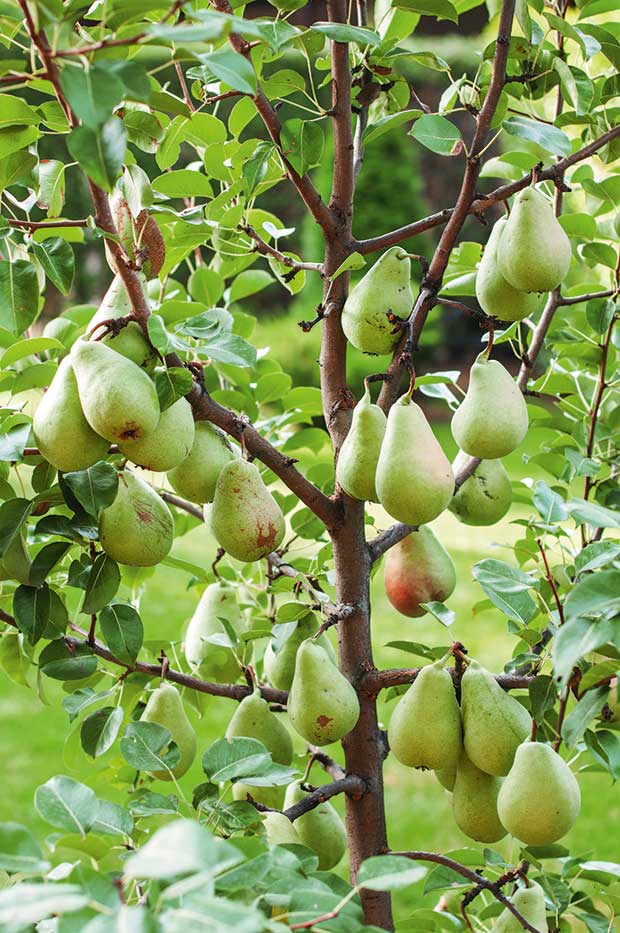
Source Image: thisnzlife.co.nz
Site Selection and Soil Preparation
Proper site selection and soil preparation are foundational for healthy pear trees.
Choosing the Ideal Location
Pears need full sun and well-drained soil. Select a site that gets at least 6-8 hours of sunlight daily.
| Factor | Consideration |
|---|---|
| Sunlight | Full sun (6-8 hours) |
| Drainage | Well-drained soil |
| Wind Protection | Sheltered from strong winds |
| Space | Adequate room for growth |
Sunlight and Shade Requirements
While pears prefer full sun, they can tolerate some light shade, especially in hotter climates.
| Sunlight | Impact on Growth |
|---|---|
| Full Sun | Optimal growth and fruit production |
| Partial Shade | Reduced fruiting, slower growth |
| Full Shade | Poor growth, minimal fruiting |
Soil Types and pH Levels
Pears thrive in loamy soil with a pH of 6.0-7.0. Soil testing can determine pH levels and nutrient content.
| Soil Type | Suitability |
|---|---|
| Sandy Loam | Excellent drainage and fertility |
| Clay | Poor drainage; amend with organic matter |
| Silty | Good fertility but moderate drainage |
| pH Level | Ideal range: 6.0-7.0 |
Soil Amendments and Fertility
Improving soil fertility with organic matter and proper amendments enhances pear tree health.
| Amendment | Benefit |
|---|---|
| Compost | Increases organic matter and nutrients |
| Manure | Boosts nitrogen and other nutrients |
| Lime | Raises soil pH |
| Sulfur | Lowers soil pH |
Planting Pear Trees
Planting pear trees correctly ensures they establish well and grow vigorously.
Best Time of Year to Plant
The best time to plant pear trees is in early spring or late fall when the trees are dormant.
| Season | Reason |
|---|---|
| Early Spring | Allows full growing season to establish |
| Late Fall | Dormant period; reduces transplant shock |
| Avoid Summer | Heat stress and water demand |
Bare Root vs. Container Grown Trees
Choosing between bare root and container-grown trees depends on availability and personal preference.
| Type | Advantages | Disadvantages |
|---|---|---|
| Bare Root | Easier to plant, usually cheaper | Limited planting season |
| Container Grown | Can be planted any time, established roots | More expensive, potential root circling |
Proper Spacing and Depth
Proper spacing prevents overcrowding and ensures healthy growth.
| Tree Size | Spacing |
|---|---|
| Standard | 20-25 feet |
| Semi-Dwarf | 12-15 feet |
| Dwarf | 8-10 feet |
Initial Watering and Mulching
Proper watering and mulching help establish young trees.
| Step | Details |
|---|---|
| Initial Watering | Water thoroughly after planting |
| Mulching | Apply 2-3 inches of mulch around base |
| Avoid Mulch Contact | Keep mulch away from trunk |
Watering and Irrigation
Consistent watering is key to healthy pear trees.
Establishing a Watering Schedule
Water newly planted trees regularly until established.
| Stage | Frequency |
|---|---|
| Newly Planted | Weekly, deep watering |
| Established Trees | Bi-weekly, deep watering |
| Mature Trees | As needed, based on rainfall |
Signs of Overwatering and Underwatering
Recognizing signs of water stress helps in adjusting irrigation.
| Condition | Symptoms |
|---|---|
| Overwatering | Yellow leaves, root rot |
| Underwatering | Wilting, dry leaves |
Drip Irrigation Systems
Drip irrigation is an efficient way to water pear trees.
| Benefit | Explanation |
|---|---|
| Water Efficiency | Delivers water directly to roots |
| Reduced Disease | Keeps foliage dry, reducing disease risk |
| Customizable | Easily adjustable to tree needs |
Water Conservation Techniques
Implementing water conservation techniques helps maintain soil moisture.
| Technique | Description |
|---|---|
| Mulching | Reduces evaporation |
| Soil Amendments | Improves water retention |
| Rainwater Harvesting | Collects and stores rainwater |

Source Image: www.pinterest.com
Fertilizing Pear Trees
Proper fertilization supports tree growth and fruit production.
Nutrient Requirements for Pears
Understanding nutrient needs helps in applying the right fertilizers.
| Nutrient | Role |
|---|---|
| Nitrogen (N) | Promotes leaf and shoot growth |
| Phosphorus (P) | Supports root and flower development |
| Potassium (K) | Enhances overall health and fruit quality |
Organic vs. Synthetic Fertilizers
Choosing between organic and synthetic fertilizers depends on gardening preferences.
| Type | Advantages | Disadvantages |
|---|---|---|
| Organic | Improves soil health, slow-release | May be less concentrated |
| Synthetic | Immediate results, precise nutrients | Can harm soil life if overused |
Timing and Application Methods
Applying fertilizers at the right time ensures effectiveness.
| Season | Application Method |
|---|---|
| Early Spring | Apply balanced fertilizer around drip line |
| Late Spring | Light application of nitrogen |
| Fall | Avoid fertilizing to prevent new growth |
Soil Testing and Adjustments
Regular soil testing helps in making necessary adjustments.
| Test | Adjustment |
|---|---|
| pH Test | Add lime to raise pH, sulfur to lower |
| Nutrient Test | Apply specific fertilizers as needed |
Pruning and Training
Proper pruning and training improve tree health and fruit production.
Importance of Pruning for Health and Yield
Pruning helps in maintaining tree shape and removing diseased wood.
| Benefit | Explanation |
|---|---|
| Increased Yield | Removes overcrowded branches |
| Disease Prevention | Removes diseased or dead wood |
| Shape Maintenance | Promotes desired growth structure |
Pruning Techniques for Young and Mature Trees
Different techniques are used for young and mature trees.
| Tree Age | Technique |
|---|---|
| Young Trees | Light pruning to shape and train |
| Mature Trees | Thinning, removing old wood |
Training Systems (Central Leader, Open Center)
Training systems shape the tree for optimal growth and fruit production.
| System | Description |
|---|---|
| Central Leader | Single dominant trunk, pyramid shape |
| Open Center | Multiple main branches, vase shape |
Managing Tree Height and Spread
Controlling height and spread ensures easy maintenance and harvesting.
| Method | Description |
|---|---|
| Regular Pruning | Keeps tree manageable |
| Summer Pruning | Reduces vigorous growth |
Pollination Requirements
Proper pollination is essential for fruit set in pears.
Self-Pollinating vs. Cross-Pollinating Varieties
Understanding pollination needs helps in planning your orchard.
| Type | Varieties |
|---|---|
| Self-Pollinating | Bartlett, Comice |
| Cross-Pollinating | Anjou, Bosc |
Best Pollinator Partners
Choosing compatible varieties ensures successful pollination.
| Variety | Pollinator Partner |
|---|---|
| Bartlett | Anjou, Bosc |
| Anjou | Bartlett, Bosc |
| Bosc | Anjou, Bartlett |
Attracting Pollinators to Your Garden
Attracting bees and other pollinators enhances fruit set.
| Method | Details |
|---|---|
| Planting Flowers | Attracts bees and beneficial insects |
| Providing Water | Encourages pollinator visits |
| Avoiding Pesticides | Protects pollinator health |
Hand Pollination Techniques
In small orchards, hand pollination can be effective.
| Step | Description |
|---|---|
| Collecting Pollen | Use a small brush to gather pollen |
| Transferring Pollen | Brush pollen onto stigmas of flowers |

Source Image: gardenerspath.com
Pest and Disease Management
Managing pests and diseases is crucial for healthy pear trees.
Common Pests (Codling Moth, Pear Psylla, Aphids)
Identifying and controlling common pests protects your trees.
| Pest | Symptoms | Control Method |
|---|---|---|
| Codling Moth | Worms in fruit, holes in pears | Pheromone traps, insecticides |
| Pear Psylla | Sticky honeydew, sooty mold | Neem oil, insecticidal soap |
| Aphids | Curling leaves, sticky residue | Ladybugs, horticultural oil |
Disease Identification and Prevention (Fire Blight, Scab)
Recognizing and preventing diseases keeps trees healthy.
| Disease | Symptoms | Prevention |
|---|---|---|
| Fire Blight | Blackened branches, ooze from bark | Prune infected branches, copper spray |
| Scab | Dark spots on leaves and fruit | Fungicide application, clean debris |
Organic and Chemical Control Methods
Choosing the right control methods depends on your gardening philosophy.
| Method | Description | Examples |
|---|---|---|
| Organic | Uses natural substances and practices | Neem oil, beneficial insects |
| Chemical | Synthetic pesticides and fungicides | Insecticides, fungicides |
Integrated Pest Management (IPM)
IPM combines multiple strategies for effective pest control.
| Component | Description |
|---|---|
| Monitoring | Regular inspection of trees |
| Biological Control | Using natural predators |
| Cultural Practices | Proper pruning, sanitation |
Harvesting Pears
Harvesting pears at the right time ensures the best flavor and quality.
Determining Ripeness
Knowing when pears are ripe helps in timely harvesting.
| Method | Indicator |
|---|---|
| Firmness | Yields slightly to pressure |
| Color | Changes from green to yellow (variety-dependent) |
| Taste | Sweet and juicy |
Proper Harvesting Techniques
Using the right techniques prevents damage to fruit.
| Step | Description |
|---|---|
| Gentle Pull | Twist and pull gently to detach |
| Use Clippers | For hard-to-reach fruit |
| Avoid Dropping | Handle carefully to avoid bruising |
Post-Harvest Handling
Proper handling ensures pears remain fresh.
| Step | Description |
|---|---|
| Cool Storage | Store in a cool, humid place |
| Regular Inspection | Check for rot or damage |
| Controlled Ripening | Store at room temperature for ripening |
Storage and Ripening Tips
Storing pears correctly prolongs their freshness.
| Method | Details |
|---|---|
| Refrigeration | Slows down ripening |
| Paper Bag Method | Speeds up ripening |
| Freezing | For long-term storage |
Maintaining Tree Health
Regular care ensures your pear trees remain productive for years.
Regular Monitoring and Inspection
Frequent checks help in early detection of issues.
| Frequency | Task |
|---|---|
| Weekly | Inspect for pests and diseases |
| Seasonal | Perform major pruning and fertilization |
| After Storms | Check for physical damage |
Seasonal Care Tasks (Spring, Summer, Fall, Winter)
Caring for pear trees throughout the year promotes health and productivity.
| Season | Task |
|---|---|
| Spring | Pruning, fertilizing, pest control |
| Summer | Watering, monitoring growth |
| Fall | Harvesting, mulching |
| Winter | Protecting from frost, dormant pruning |
Managing Stress Factors (Drought, Frost)
Addressing stress factors helps maintain tree health.
| Stress Factor | Mitigation Strategy |
|---|---|
| Drought | Deep watering, mulching |
| Frost | Covering trees, using frost blankets |
Rejuvenation of Older Trees
Rejuvenating old trees can restore their vigor.
| Method | Details |
|---|---|
| Heavy Pruning | Remove old, unproductive wood |
| Fertilization | Boost with balanced fertilizer |
| Pest Control | Address any ongoing pest issues |
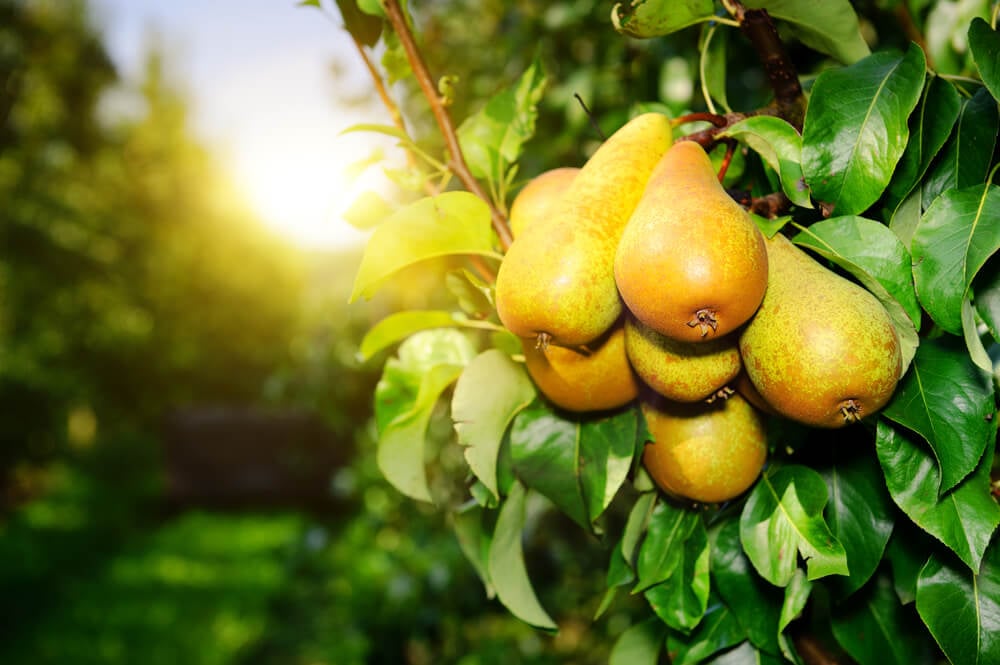
Source Image: thegardeningdad.com
How To Grow Pears
Organic Pear Growing
Organic cultivation benefits both the environment and your health.
Benefits of Organic Cultivation
Organic growing practices promote a healthier ecosystem.
| Benefit | Explanation |
|---|---|
| Soil Health | Enhances soil microbiome |
| Reduced Chemicals | Limits exposure to synthetic pesticides |
| Ecosystem Support | Supports biodiversity |
Organic Soil Amendments and Fertilizers
Using organic amendments improves soil fertility.
| Amendment | Benefit |
|---|---|
| Compost | Adds organic matter and nutrients |
| Bone Meal | Provides phosphorus |
| Fish Emulsion | Rich in nitrogen and trace elements |
Natural Pest and Disease Control
Organic methods help manage pests and diseases without chemicals.
| Method | Description |
|---|---|
| Beneficial Insects | Ladybugs, lacewings |
| Neem Oil | Effective against many pests |
| Garlic Spray | Natural insect repellent |
Certification and Standards
Understanding organic certification can help in selling your produce.
| Certification | Requirements |
|---|---|
| USDA Organic | No synthetic pesticides, GMOs |
| Certified Naturally Grown | Farmer-to-farmer certification |
| Organic Inputs | Only approved organic inputs |
Growing Pears in Containers
Growing pears in containers is ideal for small spaces.
Choosing the Right Container
Selecting the right container ensures healthy growth.
| Factor | Consideration |
|---|---|
| Size | At least 18 inches in diameter |
| Material | Terracotta, plastic, or wood |
| Drainage | Must have drainage holes |
Soil Mixes and Drainage
Proper soil mix and drainage are crucial for container-grown pears.
| Component | Role |
|---|---|
| Potting Soil | Base medium |
| Perlite | Improves drainage |
| Compost | Adds nutrients |
Care and Maintenance in Limited Space
Managing pears in containers requires special care.
| Task | Frequency |
|---|---|
| Watering | More frequent due to limited soil |
| Fertilizing | Monthly with balanced fertilizer |
| Pruning | Regularly to manage size |
Overwintering Potted Pear Trees
Protecting container trees in winter is essential.
| Method | Details |
|---|---|
| Move Indoors | Place in a garage or basement |
| Insulate | Wrap pot with burlap or bubble wrap |
| Mulch Surface | Mulch to protect roots |
Grafting and Propagation Techniques
Grafting and propagation can expand your pear collection.
Basics of Grafting Pear Trees
Grafting combines desirable traits of different trees.
| Component | Description |
|---|---|
| Rootstock | Provides root system |
| Scion | Provides fruiting wood |
| Union | Point where grafts are joined |
Choosing Rootstocks and Scions
Selecting compatible rootstocks and scions is crucial.
| Rootstock | Characteristic |
|---|---|
| Dwarfing | Limits tree size |
| Disease Resistant | Provides resistance to common diseases |
| Vigorous | Promotes strong growth |
Step-by-Step Grafting Methods
Following proper grafting methods ensures success.
| Step | Description |
|---|---|
| Collecting Scions | During dormant season |
| Making Cuts | Clean, angled cuts on scion and rootstock |
| Securing Graft | Wrap with grafting tape or rubber bands |
Propagating Pears from Cuttings and Seeds
Propagation from cuttings and seeds offers an alternative to grafting.
| Method | Details |
|---|---|
| Cuttings | Use hardwood cuttings in late fall |
| Seeds | Stratify seeds before planting |
Companion Planting
Companion planting enhances the health and yield of pear trees.
Benefits of Companion Planting for Pear Trees
Companion planting supports tree health and productivity.
| Benefit | Description |
|---|---|
| Pest Control | Attracts beneficial insects |
| Improved Soil | Adds nutrients and organic matter |
| Biodiversity | Creates a balanced ecosystem |
Best Companion Plants (Herbs, Flowers, Other Fruits)
Selecting the right companions improves pear tree health.
| Plant | Benefit |
|---|---|
| Marigolds | Repels pests |
| Comfrey | Adds nutrients, attracts pollinators |
| Clover | Fixes nitrogen in the soil |
Creating a Biodiverse Orchard
Diversity in your orchard promotes a healthy environment.
| Element | Description |
|---|---|
| Multiple Species | Plant a variety of fruit trees and herbs |
| Pollinator Habitat | Include flowers and water sources |
| Natural Pest Control | Use beneficial insects and plants |
Managing Competition and Supportive Planting
Balancing competition and support among plants ensures optimal growth.
| Strategy | Description |
|---|---|
| Spacing | Ensure adequate space between plants |
| Intercropping | Planting mutually beneficial species |
| Mulching | Reduces competition for water and nutrients |
Dealing with Environmental Challenges
Managing environmental challenges is key to successful pear growing.
Frost Protection and Winter Care
Protecting trees from frost damage ensures their survival.
| Method | Details |
|---|---|
| Frost Covers | Use frost blankets during cold snaps |
| Mulching | Insulates roots during winter |
| Windbreaks | Plant windbreaks to protect from cold winds |
Drought Management Strategies
Effective drought management keeps trees healthy during dry periods.
| Strategy | Description |
|---|---|
| Deep Watering | Encourages deep root growth |
| Mulching | Retains soil moisture |
| Drip Irrigation | Efficient water use |
Windbreaks and Shelterbelts
Windbreaks protect pear trees from damage and stress.
| Type | Description |
|---|---|
| Natural | Rows of trees and shrubs |
| Artificial | Fences or screens |
Adapting to Climate Change
Adapting practices to changing climate conditions ensures long-term success.
| Adaptation | Details |
|---|---|
| Heat Tolerance | Select heat-tolerant varieties |
| Water Management | Implement efficient irrigation systems |
| Disease Resistance | Choose disease-resistant varieties |
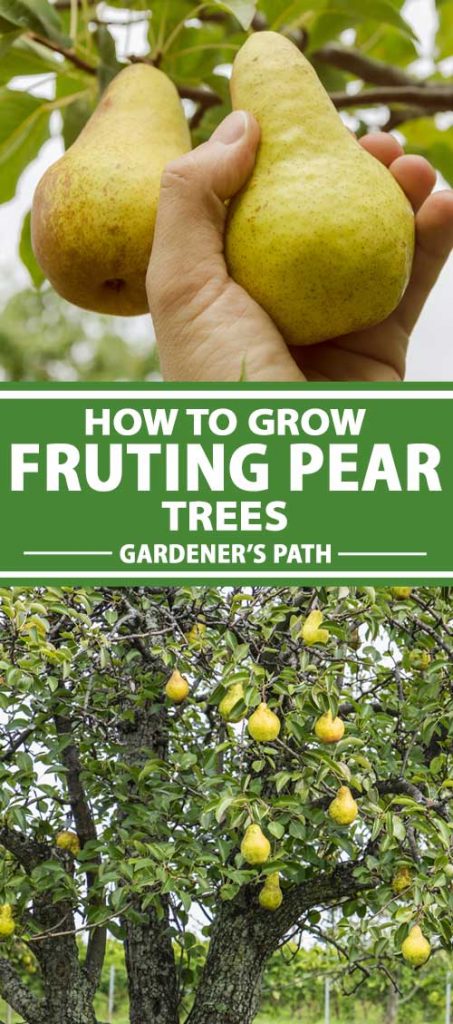
Source Image: gardenerspath.com
Pear Tree Varieties for Different Uses
Choosing varieties for specific purposes maximizes your harvest’s utility.
Best Pears for Fresh Eating
Selecting the best pears for fresh eating ensures delicious, juicy fruit.
| Variety | Flavor |
|---|---|
| Bartlett | Sweet and juicy |
| Comice | Very sweet, creamy texture |
| Asian Pears | Crisp, apple-like texture |
Varieties Suited for Cooking and Baking
Some pears excel in cooking and baking due to their texture.
| Variety | Characteristic |
|---|---|
| Bosc | Firm, holds shape when cooked |
| Anjou | Mild flavor, good for poaching |
| Seckel | Small, sweet, ideal for desserts |
Pears Ideal for Preserving and Canning
Certain varieties are perfect for preserving due to their consistency and flavor.
| Variety | Characteristic |
|---|---|
| Bartlett | Holds shape, sweet |
| Anjou | Firm, good for slicing |
| Kieffer | Hardy, resistant to spoilage |
Specialty and Rare Varieties
Exploring unique pear varieties adds interest to your orchard.
| Variety | Characteristic |
|---|---|
| Forelle | Small, sweet, attractive color |
| Warren | Very juicy, almost buttery |
| Concorde | Aromatic, excellent fresh or cooked |
Sustainability in Pear Cultivation
Practicing sustainability ensures long-term success and environmental health.
Water Conservation Practices
Implementing water conservation practices helps in maintaining soil moisture.
| Method | Description |
|---|---|
| Drip Irrigation | Efficient water use |
| Mulching | Reduces evaporation |
| Rainwater Harvesting | Collects and stores rainwater |
Sustainable Fertilizing and Soil Health
Sustainable practices maintain soil health and fertility.
| Practice | Description |
|---|---|
| Composting | Adds organic matter and nutrients |
| Cover Crops | Improve soil structure and fertility |
| Crop Rotation | Reduces soil nutrient depletion |
Biodiversity and Ecosystem Health
Promoting biodiversity supports a healthy ecosystem.
| Element | Description |
|---|---|
| Mixed Plantings | Reduces pest outbreaks |
| Wildlife Habitat | Supports beneficial insects and birds |
| Native Plants | Enhance local biodiversity |
Reducing Carbon Footprint in Home Orchards
Minimizing carbon footprint contributes to environmental sustainability.
| Practice | Description |
|---|---|
| Local Sourcing | Use locally sourced materials |
| Organic Practices | Reduce chemical inputs |
| Renewable Energy | Use solar or wind power in the garden |
/pears-growing-in-tree-blue-sky-d2d9c4020ce44c249a65464c2c669b8c.jpg)
Source Image: www.bhg.com
Troubleshooting Common Problems
Addressing common issues ensures healthy pear trees and bountiful harvests.
Diagnosing Poor Growth and Development
Identifying growth issues helps in taking corrective actions.
| Symptom | Possible Cause | Solution |
|---|---|---|
| Stunted Growth | Nutrient deficiency, poor soil | Soil testing, fertilization |
| Yellow Leaves | Overwatering, nutrient deficiency | Adjust watering, apply appropriate fertilizer |
| Poor Fruit Set | Lack of pollination, improper pruning | Ensure cross-pollination, proper pruning |
Handling Fruit Drop and Low Yield
Preventing fruit drop and increasing yield requires proper care.
| Symptom | Possible Cause | Solution |
|---|---|---|
| Premature Fruit Drop | Water stress, pest damage | Consistent watering, pest control |
| Low Yield | Poor pollination, nutrient deficiency | Ensure proper pollination, fertilize appropriately |

Source Image: gardeningtips.in
How To Grow Pears
Dealing with Environmental Stress
Managing environmental stress factors keeps trees healthy.
| Symptom | Cause | Solution |
|---|---|---|
| Sunscald | Excessive sun exposure | Use tree wraps, provide shade |
| Frost Damage | Late spring frost | Protect with frost covers, mulch roots |
Long-Term Solutions for Persistent Issues
Implementing long-term solutions ensures sustainable pear cultivation.
| Problem | Solution |
|---|---|
| Soil Degradation | Regular organic amendments, cover crops |
| Persistent Pests | Integrated Pest Management (IPM) |
| Disease Recurrence | Resistant varieties, proper sanitation |
By following these comprehensive guidelines on pear cultivation, from planting and care to harvesting and sustainability, you can enjoy a productive and healthy pear orchard. Understanding and addressing the specific needs of pear trees ensures a bountiful harvest and contributes to long-term environmental health.

